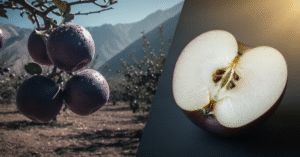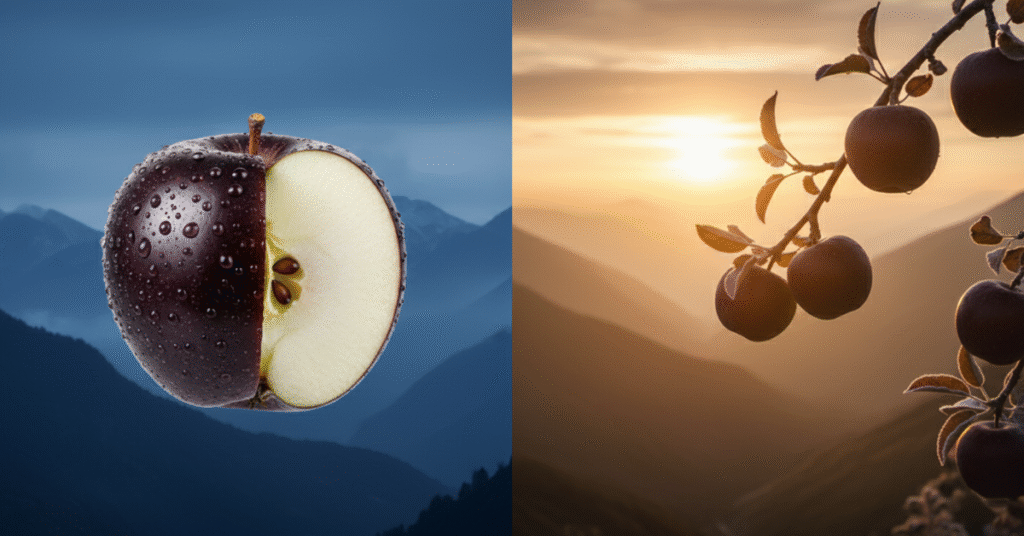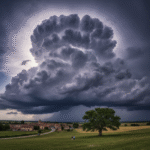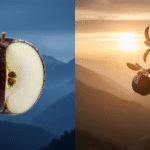For centuries, apples have been defined by their bright reds, vibrant greens, and sunny yellows. But imagine biting into an apple so dark it looks like it came straight out of a night sky—an apple that commands attention and is almost black in appearance. Meet the Black Diamond Apple. It’s not a myth or a Photoshop creation; it’s a real, incredibly rare fruit grown in the remote mountains of Tibet.
When I first came across the fact that an apple could genuinely be black, I was fascinated. I knew instantly this was a story FACTOVATE readers needed to hear. This is one of the world’s most unique pieces of produce, defined by its intense, almost purple-black hue, and it holds several secrets about farming, rarity, and flavor.
What Makes the Black Diamond Apple So Unique?
The intense color is the first thing everyone notices. Unlike regular apples, the Black Diamond Apple develops its dark, waxy skin due to a specific combination of genetics and extreme environmental conditions. The color is not chemically treated; it’s natural.
This apple is a variant of the Hua Niu apple (also known as the Chinese Red Delicious), but it gets its deep color because it is cultivated in the mountainous regions of Nyingchi, Tibet, at an altitude of over 3,500 meters (around 11,500 feet).
Here is why this altitude is so important:
- Extreme Temperatures: The days are intensely hot, and the nights are severely cold.
- Intense Sunlight: The high altitude exposes the apples to very high levels of ultraviolet (UV) radiation.
This huge fluctuation in temperature and extreme UV exposure causes the skin of the apple to develop its signature dark purple-black pigment, which acts as a defense mechanism against the harsh sun. This is a perfect example of nature adapting in a fascinating way.
The Taste: Sweeter Than Honey?
If the look is striking, the taste is often described as surprising. Given its dark and somewhat serious appearance, many people expect the Black Diamond Apple to have a harsh or tart flavor. The truth is quite the opposite.
This apple is known for its crispness and a taste that is notably sweeter than most common apples. Because of the thick skin developed to protect it from UV light, the flesh inside remains bright white and incredibly juicy. The high altitude means the apples mature slowly, locking in sugars and resulting in a rich, mild flavor that some describe as similar to honey.
This slow maturation process contributes to the fruit’s highly desired crispness and juiciness, making it a favorite among those who are lucky enough to try it.

Rarity and Pricing: Why You Can’t Find It Easily
If the Black Diamond Apple is so amazing, why haven’t you seen it at your local market? The answer lies in its demanding growing environment and the economic realities of farming.
- Limited Geographic Area: It can only be successfully grown at the high altitudes of Tibet where those specific environmental conditions exist.
- Long Maturation Cycle: The apples take longer to mature, meaning farmers get fewer harvests in a season.
- Low Yield: The trees are highly susceptible to disease and insect damage due to the tough terrain, resulting in a low yield compared to commercial orchards.
Due to this rarity and the high cost of farming in remote areas, the price of a single Black Diamond Apple is exceptionally high, often selling for $7 to $20 USD per fruit in high-end Chinese supermarkets. For this reason, it is often marketed as a luxury gift item rather than a common snack.
The Black Diamond Apple vs. Other Black Fruits
Sometimes this apple is confused with other dark fruits, or even mistakenly referred to as the “Black Pearl Apple” due to its dark, jewel-like quality. However, the Black Diamond Apple is distinct. Its unique, near-black skin is a true phenomenon of nature’s defense against UV light at extreme altitudes, setting it apart from other dark-skinned varieties found elsewhere in the world.
It serves as a wonderful reminder that the most interesting facts often come from the most remote corners of the planet.






